Muddle in the Middle: The “C” in TCU
The question has risen more than once; often in quiet conversation, seldom in public debate. Now, in a time when “Christian” carries myriad connotations, some wonder: What does the “C” in TCU really mean? We decided to ask an expert. Church historian and chancellor emeritus William E. Tucker has a lifetime connection to TCU, including 19 years at the helm. With some prodding, he agreed to share his perspective with the magazine, as did a few others. We think you’ll discover in these answers what we did: You put the “C” in TCU.
Muddle in the Middle: The “C” in TCU
The question has risen more than once; often in quiet conversation, seldom in public debate. Now, in a time when “Christian” carries myriad connotations, some wonder: What does the “C” in TCU really mean? We decided to ask an expert. Church historian and chancellor emeritus William E. Tucker has a lifetime connection to TCU, including 19 years at the helm. With some prodding, he agreed to share his perspective with the magazine, as did a few others. We think you’ll discover in these answers what we did: You put the “C” in TCU.
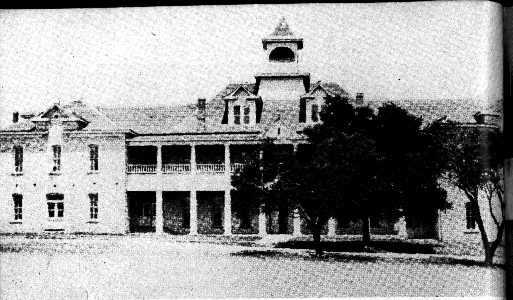 Names of institutions as well as individuals have claimed my interest and fired my imagination for as far back as I can remember. It is more than a fleeting curiosity to me, therefore, that come 2002 Texas Christian University will have served for a solid century to identify the 128-year-old TCU.
Names of institutions as well as individuals have claimed my interest and fired my imagination for as far back as I can remember. It is more than a fleeting curiosity to me, therefore, that come 2002 Texas Christian University will have served for a solid century to identify the 128-year-old TCU.
Whatever one thinks of the name, it has the decided advantage of being one-of-a-kind. There is a Texas Christian Academy, as I recall, but no other Texas Christian University on the face of the earth. Unique or not, some names fit and wear well, standing the test of time, while others lose their effectiveness and fall victim to change.
Consider Texas Christian University. What do the three words, especially the one in the middle, signify and how are they perceived? Does the name carry positive or negative freight or both? Is it an adequate designation for a thriving institution of higher education firm in its resolve to stress inclusiveness, to grow diversity, to reflect a global vision in attitude and programs? Good questions, every one.
Although any serious assessment of the name must take into full account today’s needs and tomorrow’s promise, we shortchange ourselves by ignoring yesterday. If, as I think, heritage plays a key role in shaping destiny, an attempt to understand the past is not only appropriate but also essential.
However courageous and laudable the effort, launching schools like TCU was hardly uncommon in the aftermath of the Civil War. The post-war era proved to be a hothouse of industry and higher education alike. Would-be educators, motivated by mission and touched with ambition, seized the opportunity to quench the nation’s perceived thirst for learning. Literally hundreds of so-called colleges were planted in towns and hamlets across the land; a shocking number of them wilted as quickly as they sprouted. With a wry grin, one of my late colleagues observed that the shoreline of American history is littered with the wrecks of abandoned colleges. In contrast to Plattsburg and Rockport, TCU survived, a signal accomplishment in itself. No wonder Joseph Lynn Clark’s history of the founding family bears the title, Thank God, We Made It!
The year was 1873; the place, Thorp Spring, a stagecoach stop on the cattle frontier in Hood County, (about forty miles southwest of Fort Worth). There, on the first Monday in September, the brothers Clark, Addison and Randolph, with the strong assistance of their father, Joseph Addison, opened the doors of what we know today as TCU. The founders named their school AddRan Male and Female College in honor of Addison’s firstborn, who died of diphtheria at the age of 3. The current name would emerge close to three decades later. Actually, Addison, president from 1873 to 1899, objected to calling AddRan a Christian college because he did not want to “denominationalize” (his word) the name.
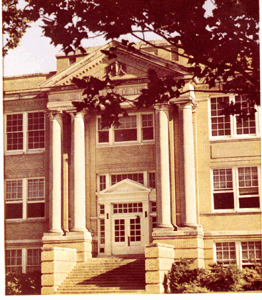 Even more curious than the absence of Christian was the pointed reference to women. TCU partisans nowadays take pride, and justifiably so, in the progressiveness of the founders who, ahead of their time, welcomed both girls and boys. No doubt a practical consideration figured in their thinking. They foresaw challenges aplenty without attempting to build on a narrow — i.e., male only — base. They needed pupils. Thirteen showed up on opening day.
Even more curious than the absence of Christian was the pointed reference to women. TCU partisans nowadays take pride, and justifiably so, in the progressiveness of the founders who, ahead of their time, welcomed both girls and boys. No doubt a practical consideration figured in their thinking. They foresaw challenges aplenty without attempting to build on a narrow — i.e., male only — base. They needed pupils. Thirteen showed up on opening day.
Sole proprietors of AddRan College, the preacher-teacher Clarks turned to the church, their church, for encouragement and assistance. In response, the Christian Brotherhood of Texas promptly “adopted and endorsed” the fledgling enterprise but offered no specific guarantee of financial backing. Regardless of who raised the money and paid the bills, AddRan was intended and perceived to be a church-related college from day one.
The “Brotherhood,” nicknamed Campbellites in some circles, was part of that religious body originating on the American frontier early in the 19th-century under the leadership of Barton W. Stone and Alexander Campbell. Over time the movement developed an identity problem of its own. The co-founders could not agree on a name. Mr. Campbell proposed Disciples. Mr. Stone preferred the designation of Christian. They never resolved the issue, and folks have been confused about the matter ever since.
The official name of the mainstream Protestant denomination is Christian Church (Disciples of Christ). Although adherents refer to themselves as Disciples of Christ or simply Disciples, their local congregations are identified with rare exceptions as Christian (University Christian in Fort Worth, for example, and First Christian in cities and towns across the land and beyond).
Compounding the complexity, the Stone-Campbell tradition gave rise to yet another Protestant body known as Churches of Christ. To the right of and much larger than Disciples, they are associated with a number of institutions of higher education including Abilene Christian University in Texas and Pepperdine University in California.
Working in the vineyard of the Lord, the Clarks attracted enough interest among congregations and families to keep their school alive. Success, however, was marginal. Excepting several years, annual enrollment ranged between 300 and 400. The struggle to match income with expenditures never let up.
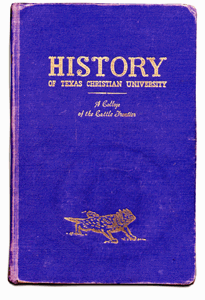 The brothers, together with their wives — Sally McQuigg Clark and Ella Blanche Lee Clark — had poured their lives and fortunes into the venture. Still, AddRan had no endowment and faced an uncertain future. What to do? The question weighed heavily.
The brothers, together with their wives — Sally McQuigg Clark and Ella Blanche Lee Clark — had poured their lives and fortunes into the venture. Still, AddRan had no endowment and faced an uncertain future. What to do? The question weighed heavily.
Only one answer seemed worthy of consideration to Addison and Randolph. If their school was to survive them, they had no acceptable choice but to give it to the church. The transfer became effective at the 1889 convention of the Texas Christian Missionary Society, meeting in Fort Worth. The terms of the gift, valued at $43,000, specified that a board of trustees hold title to the property for the church. Within a few weeks, the newly formed governing board convened and renamed the school AddRan Christian University.
Having relinquished control and ceded all assets, the brothers remained with the University, Randolph until 1895 and Addison until 1901. They disagreed with the name change but made no fuss about it.
The shift in name, signaling an even stronger tie to the church, appeared to make little difference in the fortunes of the school. Anticipated growth in number of students and size of contributions failed to materialize, prompting the trustees to say goodbye to Thorp Spring and relocate AddRan in Waco. There the University languished until fire destroyed the only major building on campus and made feasible the move to Fort Worth in 1910.
Eight years earlier the name had been revised for the second time. Henceforth the school planted and nurtured by the Clarks would be known as Texas Christian University. Finally, the trustees, settling on a name with staying power, got it right. Or did they?
Dropping the treasured symbol of the Clark name did not sit well in certain quarters, even though the board, with strong support from the influential T. E. Shirley, approved a motion stipulating “that the Department of Arts and Sciences be called the AddRan College of Arts and Sciences.” A number of graduates in the Thorp Spring era and several members of the founders’ families made known their disappointment and resentment. Said Dean Colby D. Hall: “Some loyalties were lost, some later regained, some never.”
Even if not widespread, dissatisfaction with the new name persisted and came into view little more than a decade later on the modest pages of TCU Grad. All but forgotten, the monthly was published for a brief period by the Dallas Chapter of the TCU Alumni Association. Writing in the January issue of 1914, Ellsworth Faris, class of 1894, gave his article a straight-to-the-point title: “Let Us Change Her Name for the Last Time.”
Faris took exception to every part of the name. Calling TCU a university was dishonest. To use his words: “As a matter of plain, honest fact, TCU is not and never has been a university in any fair meaning of the word. More than that, we are not even a first-class college.” He objected to the use of Texas on the grounds that any geographical designation was confining and therefore misguided. And he “emphatically” voted “against putting ‘Christian’ into the name at all.”
As an alternative, Faris suggested that a wealthy individual might be moved to give a fortune in exchange for the name. If not, he concluded, “let us call it Clark College, after him who gave all his active life to the school and who left it just because he thought it would thus be advanced in allowing more modern men to come into leadership.”
 Instead of taking Faris to task, the letters of response (at least those the editor chose to print) sided with him by and large. Douglas Tomlinson, class of 1909, wanted a shorter name. So did Bonner Frizzell, class of 1909, who said: “I have never been satisfied with the cumbersome, three-storied name with which the school has been burdened.” In the judgment of Tom Dean, class of 1913, TCU’s “other name, her true name is Clark. It has always been. Those who have been inspired by her spirit have learned to speak the name ‘Clark’ with an ease and a meaning that no other name can inspire. I vote ‘aye’ for Clark College.”
Instead of taking Faris to task, the letters of response (at least those the editor chose to print) sided with him by and large. Douglas Tomlinson, class of 1909, wanted a shorter name. So did Bonner Frizzell, class of 1909, who said: “I have never been satisfied with the cumbersome, three-storied name with which the school has been burdened.” In the judgment of Tom Dean, class of 1913, TCU’s “other name, her true name is Clark. It has always been. Those who have been inspired by her spirit have learned to speak the name ‘Clark’ with an ease and a meaning that no other name can inspire. I vote ‘aye’ for Clark College.”
Who could predict the outcome had the deep-rooted sentiment for “Clark” mushroomed? Perhaps the University today would find itself in the unfortunate position of sharing its treasured name with at least five other schools: Clark University in Massachusetts, Clark College in Washington, Clarke in Iowa plus Clark State Community College in Ohio and Clark-Atlanta in Georgia.
As it happened, nothing came of the articles in TCU Grad. They lie little noticed in the archives of the Mary Couts Burnett Library.
The name, Texas Christian University, stands. Close to a century later, however, the issue is not dead. Muffled rumblings persist. Doubts surface in selected settings. Texas is acceptable, even desirable. University is appropriate. But what about the “C” in TCU? That question has not gone away.
Surely I am not alone in sensing that within the university family are those who, while respectful of the past, stumble over and are slightly embarrassed by the name in the middle. Lacking in clarity and subject to misunderstanding, it is actually an impediment at a time (now) when integrated marketing has become essential to our program of university advancement. Or so the discomfited maintain. The across-the-campus highlighting of our logo, reflected on the covers of official university publications, signals a reluctance to use the C-word in identifying the University.
No wonder the middle is muddled. Christians everywhere hold in common their defining affirmation of Jesus as Christ but otherwise differ widely (and even radically, to my mind) in thought and practice. Many believers think of faith in terms of trust; others see faith as a set of doctrines. Many understand the Bible to be the record of God’s self-revelation culminating in the gift of the Man from Nazareth; others insist that the biblical text is verbally inspired — “written in heaven and bound in Morocco” — and therefore must be interpreted literally. Many fall back on creationism as the only acceptable way to account for the origin of the universe and humankind; others are equally convinced that theories of evolution (from Charles Darwin on) do not and cannot undermine the creation narratives in the Book of Genesis. Need I cite other examples?
From one generation to the next, believers march to a variety of drummers. To complicate the matter further, Webster’s Dictionary yields to convention and accepts “commendably decent or generous” as one of several definitions of the word, Christian.
I am reminded of an undergraduate professor of mine who said: “We see things as we are and not as they are.” Indeed we do, and perception takes on the authority of reality.
What, then, should we make of the name wedged between Texas and University? To bury a ludicrous misconception, let me say it directly. The C-word does not imply that TCU is now or ever was a Bible college in shape or substance. Here again we are indebted to the brothers, for they left no wiggle room on the matter. The purpose of their college, according to the Charter, “shall be for the support and promotion of literary and scientific education.” With a view to fulfilling the purpose, they organized the AddRan curriculum around six academic areas: ancient languages, English language, mathematics and physical sciences, mental and moral sciences, and social and civic history. Instead of focusing on the Old and New Testaments, the founders adopted an educational model based on the classics.
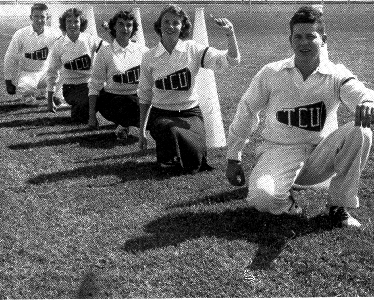 Neither does the C-word send the message that TCU is now or ever was sectarian. Almost 80 years ago this proved to be a fundamental consideration in the mind of Mary Couts Burnett, far and away the most significant donor in the entire sweep of TCU’s history. (Allowing for inflation, it would require a current gift of $100 million or more to match the Burnett bequest.) Before favoring the University, she determined TCU to be, in words from the Deed of Trust, “a nonsectarian institution, open to all alike, to those of any faith or creed, and alike to rich and poor.” An outsider, indeed a complete stranger to everyone on campus, she nevertheless could not have described the spirit of the place more accurately.
Neither does the C-word send the message that TCU is now or ever was sectarian. Almost 80 years ago this proved to be a fundamental consideration in the mind of Mary Couts Burnett, far and away the most significant donor in the entire sweep of TCU’s history. (Allowing for inflation, it would require a current gift of $100 million or more to match the Burnett bequest.) Before favoring the University, she determined TCU to be, in words from the Deed of Trust, “a nonsectarian institution, open to all alike, to those of any faith or creed, and alike to rich and poor.” An outsider, indeed a complete stranger to everyone on campus, she nevertheless could not have described the spirit of the place more accurately.
An Episcopalian, Mrs. Burnett did not let the school’s denominational connection shake her confidence, a connection acknowledged directly in the university name. However ambiguous, the “C” in TCU is meant to convey the simple message that Texas Christian University is related historically and intentionally to the Christian Church (Disciples of Christ).
Beginning with Addison Clark and continuing for a long time, I hasten to add, the institution bore all the traditional marks of a Christian college (as opposed to Bible college). Edward McShane Waits, president from 1916 to 1941, left no doubt about it. Early in his administration, as TCU alumna Kathryn Graham pointed out in her recent honor’s thesis, Prexy Waits wrote: “Texas Christian University has as its aim Christian character, Christian scholarship and Christian culture.” Warming to his topic, he added: “TCU’s supreme task is to furnish Christian leadership, and to inculcate Christian idealism based upon… the kingship and lordship of Jesus Christ.”
Moving forward about four decades, McGruder Ellis Sadler — successor to Waits — was nearing retirement. In a valedictory-like address on TCU to the Newcomen Society, he said there was “no place” for narrow religion in the academy. “But,” he added, “we are equally convinced that creative, constructive, and wholesome religion is … not just a part but a condition of all sound learning.” Note the decided shift in emphasis from “Christian scholarship” to “constructive and wholesome religion.” The contrast between Waits and Sadler is striking. How do we account for it?
Simply put, the small college led by both men changed rapidly after World War II. Programs expanded at baccalaureate and graduate levels. New buildings enhanced the campus. Fueled by the G.I. Bill, enrollment soared. Over time TCU became a university in more than name, a church-related university. And so it is today.
One of TCU’s many assets, the church tie has played a key role in shaping the tone of the institution. Among other direct benefits, two are incontestable. (1) The Christian Church (Disciples of Christ) provides a built-in constituency of students and advocates in good times and bad. (2) Although monetary support from the denomination is modest and mostly symbolic, becoming less consequential as the University grows in size and strength, gifts from individual Disciples are quite significant. I dare to mention a single example: the late Theodore P. Beasley, Dallas philanthropist and onetime chair of TCU’s Board of Trustees.
Financial considerations aside, the thought and practice of Disciples serve TCU well. Emphasizing the reasonableness of faith, Disciples believe in God with the top of their minds as well as with the bottom of their hearts. Inclusive in spirit, they are best known for their defining interest in the cause of Christian unity. As for governance, they have a bottom-up structure. The denomination by design lacks power to control local congregations much less colleges and universities and must rely on persuasion rather than coercion. All in all, the Christian Church (Disciples of Christ) is a good partner for TCU.
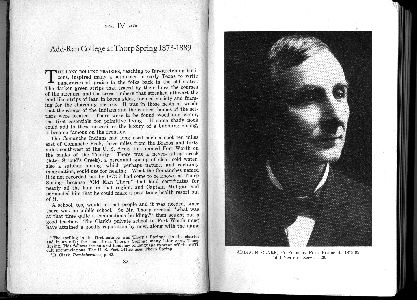 Given the nature of Disciples, the church connection could be nebulous and mean very little. To clarify the relationship, the denomination and its colleges and universities proceeded to enter into a covenantal agreement. The agreement, in effect since the late 1970s, focuses on mutual responsibilities of the parties in covenant and has not been revised in intervening years. Neither onerous nor picky, it is a model of discretion.
Given the nature of Disciples, the church connection could be nebulous and mean very little. To clarify the relationship, the denomination and its colleges and universities proceeded to enter into a covenantal agreement. The agreement, in effect since the late 1970s, focuses on mutual responsibilities of the parties in covenant and has not been revised in intervening years. Neither onerous nor picky, it is a model of discretion.
Really, the turn to a covenant caused no stir at TCU. The University already took seriously its tie to Disciples. And still does.
TCU keeps changing, of course, and no doubt always will. Good! Institutions wrapped in the status quo and bent solely on preservation are prime candidates for decline. Vitality rarely if ever springs from the soil of nostalgia. That said, I judge the expressions of church relationship on campus today to be entirely consistent with and supportive of the University’s stated mission to “educate individuals to think and act as ethical leaders and responsible citizens in a global society.”
The partnership between Disciples and TCU, in my view, is natural and expansive instead of awkward and limiting.
Still lurking in the background is the question: Has the University outgrown the church? Bear in mind that many of the topflight centers of higher learning in America began under religious auspices. William A. Clebsch said it well: “American higher education suckled at the breast of the religious mother who gave it birth and under her protection grew strong. After the Civil War it became a man and put away childish things, including its mother.” (From Sacred to Profane America, p. 136.)
Intending no disrespect to Harvard and Yale, Princeton and Vanderbilt, I ask: Does my alma mater always have to follow in their train? Maybe not. Is there a less traveled road to eminence in century twenty-one? I hope so.
Despite the muddle, I like the name, Texas Christian University. And the initials too, including the one in the middle.

Your comments are welcome
Comments
Related Reading:
Features
A Prescription for Success
TCU’s health policy program from the Neeley School of Business trains medical industry professionals in the business of health care.
Features
Campus of the Future
TCU’s Campus Master Plan builds on the university’s vision and values.